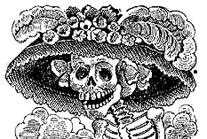|
The Ofrenda (Altar)
Each family builds and decorates an ofrenda each year. There is a special market on October 31 selling only materials for the altars and other necessities for this season, while pan de muerto and calaveras are to be found everywhere. A typical ofrenda, or altar begins with a table on which are placed boxes to represent the tombs and all is covered with a white tablecloth or sheet or with papel picado, paper cutouts with special themes related to the season. Long stalks of sugarcane or carrizo are tied to the front legs of the table, formed into a large arch over the altar, which are then decorated with flowers. The images of the saints and the family dead are placed on the altar and everywhere there are flowers: The golden flower of death, the Zempoalxochitl or Zempasúchil (a very large golden marigold), is the most prevalent color on the ofrenda. The special offerings of food may include mole, nicuatole, pumpkin cooked with brown sugar, cane sugar and tejocotes. Beautifully decorated pan de muerto, chocolate, pecans and peanuts. Cooked chayote and fresh fruits - oranges, lemons, bananas, jícama, tejocotes, nísperos and pineapple. If the deceased smoked or drank, then cigarettes and mezcal are placed on the altar together with any other special foods or items, which were a favorite in life. If the altar is for an "angelito" or child, it will also include favorite toys and many white flowers. Then comes the lamp with oil of higuerilla, the wax candles, white or yellow adorned with black crepe paper. An especially elaborate altar may also feature a colored sand and seed painting on the floor in front of it representing a particularly esteemed saint. A uniquely Mexican custom, especially prevalent in Oaxaca is the use of calaveras and catrinas and the ever-present skeletons, skulls, tombs and coffins. The calaveras are candy skulls, wood or clay figures depicting skeletons dressed as doctors, judges, teachers, footballers, tennis players, prostitutes - every conceivable profession and pastime is caricatured. Serious paintings and sculptures in the famous Oaxacan black clay and other materials appear in stores and museums, as well as on family altars. The Calaveras are also shown in drawings lampooning politicians, teachers, and friends and there is a special section of calaveras in the newspapers "honoring" those in the public eye. La Catrina is a female skeleton with the chapeau and dress of the 19th century grande dame and everywhere represents death which can catch you anywhere and anytime. With an unusually mocking gesture, Oaxacans convert Death to a near presence.
|

